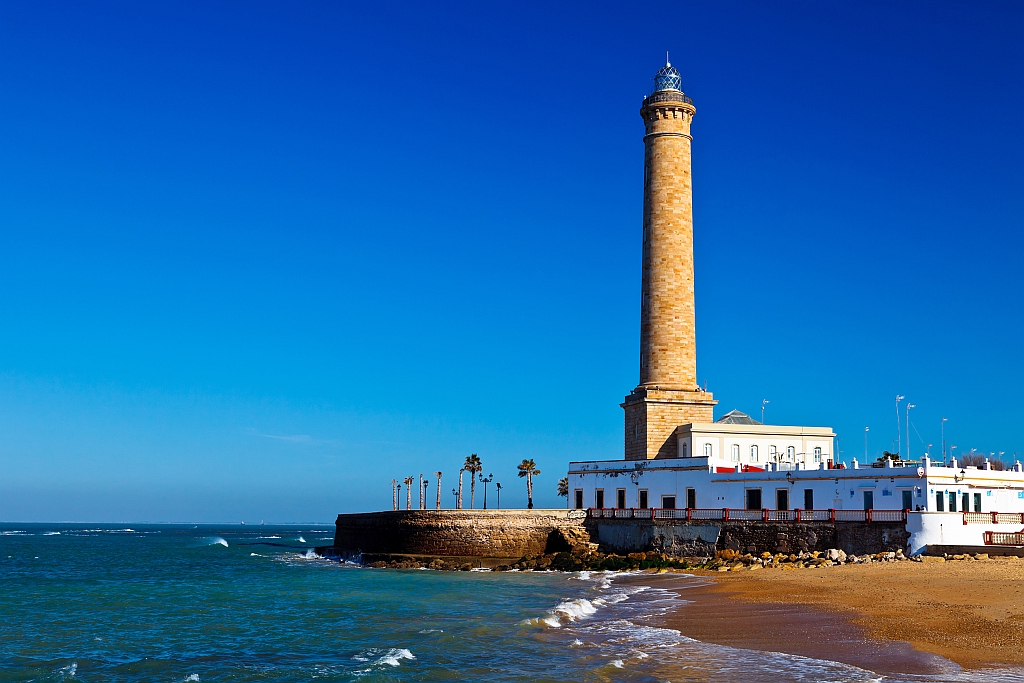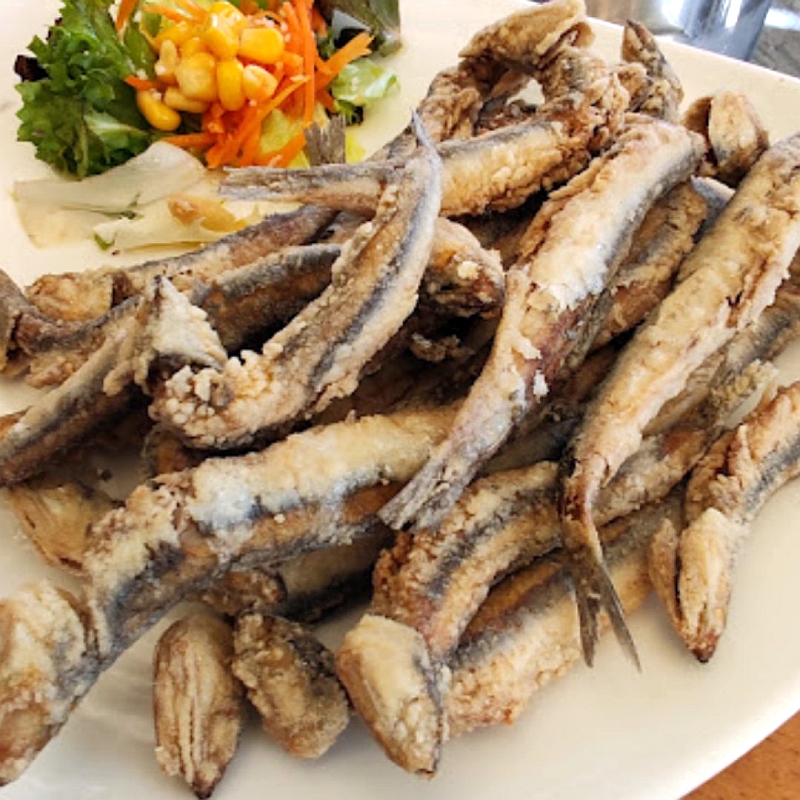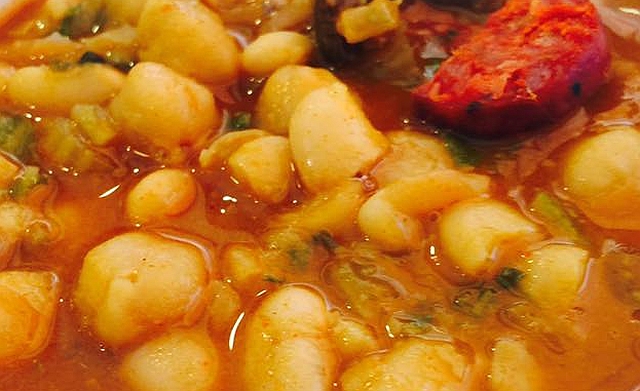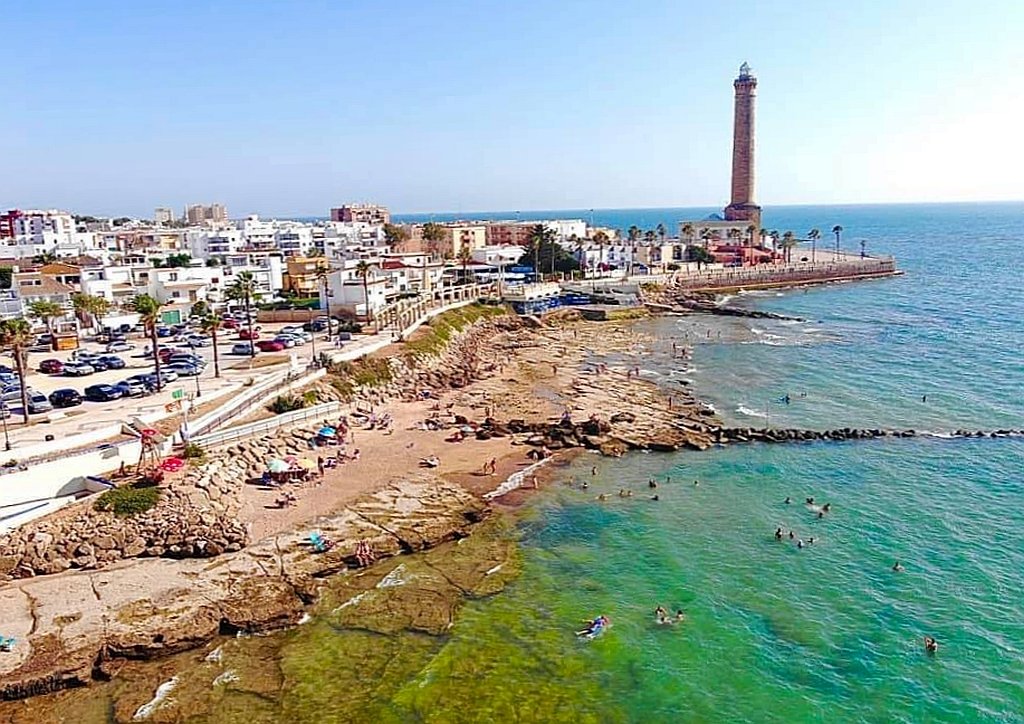Nestled along the Costa de la Luz in southern Spain, Chipiona is a charming coastal town located 54 kilometers from Cádiz. The town boasts a fascinating history, great beaches and an exceptional gastronomic tradition, making it a must-visit destination for travelers seeking an authentic Andalusian experience.
Chipiona’s economy thrives on four key sectores

Rooms feature furnished terraces with pool, golf, or sea views. Facilities include a hot tub, fitness centre, and summer entertainment, plus a free beach shuttle. Set in the Bay of Cádiz near protected dunes, it’s 10 minutes from Rota’s beaches and 36 km from Jerez Airport.
- Tourism: The town’s iodine-rich beaches attract visitors, primarily from within Spain, such as neighboring Sevilla, but international tourists are on the rise thanks to the nearby Costa Ballena resort, home to an 18-hole golf course.
- Fishing: Fishing has been a cornerstone of Chipiona’s economy since ancient times. Its fish and seafood are renowned for their high quality and flavor.
- Floriculture: Chipiona is Spain’s leading producer of flowers, exporting blooms like carnations primarily to the Netherlands.
- Viticulture: Chipiona’s vineyards produce Moscatel, Oloroso, Fino, and vinegar wines. The grape harvest in Chipiona is a unique celebration of local traditions. Read about the sherry triangle and wine tasting tours here.

A Journey Through History
Chipiona’s roots date back to the Roman era, with the Turris Caepionis lighthouse at the mouth of the Guadalquivir River. This lighthouse is believed to be the origin of the town’s name.
In the Middle Ages, Chipiona became a refuge for followers of Saint Augustine fleeing North Africa during the Vandal invasion. Later, during the 18th century, the town was devastated by a tsunami caused by the Lisbon earthquake in 1755. This led to the annual procession of the Cristo de las Misericordias, held every November 1st to commemorate the event.
The Majestic Faro de Chipiona: Spain’s Tallest Lighthouse
The Faro de Chipiona is a true marvel of maritime engineering. Standing an impressive 69 meters (226 feet) tall, this lighthouse is not only the tallest in Spain but also the third tallest in Europe and the fifth tallest in the world. With 322 steps leading to the top, it offers visitors breathtaking panoramic views of the Atlantic Ocean and the surrounding coastline.

A Guide to Its History and Purpose
Built in 1867, the Faro de Chipiona was designed by Jaime Font, a Spanish engineer, to guide ships navigating the dangerous waters at the mouth of the Guadalquivir River. This river connects to the Port of Seville, making the lighthouse a critical aid to maritime traffic for centuries. Its powerful beam can be seen from 25 nautical miles away, ensuring safe passage for countless vessels.
What Makes It Unique?
- Strategic Location: The Faro de Chipiona is situated on the Punta del Perro, a rocky promontory on the Atlantic coast. Its position was carefully chosen to warn sailors of the shallow waters and sandbanks that have long posed risks in this region.
- Impressive Engineering: Climbing the 322 steps of its spiral staircase rewards visitors with one of the most stunning vistas in Spain. From the top, you can admire views of Chipiona’s beaches, the ocean stretching to the horizon, and even glimpses of the Doñana National Park.
- Cultural Significance: This lighthouse is not just a beacon of light for sailors but also a symbol of the town’s maritime heritage. It’s deeply cherished by the local community and remains one of Chipiona’s most visited landmarks.
Fun Facts About the Faro de Chipiona
- Global Ranking: As the fifth tallest lighthouse in the world, it shares its status with other iconic lighthouses, such as the Île Vierge Lighthouse in France and the Jeddah Light in Saudi Arabia.
- Light Intensity: Its powerful lens emits flashes of light every ten seconds, ensuring visibility over long distances.
- Architectural Design: Unlike many lighthouses, the Faro de Chipiona was designed with an elegant neoclassical style, showcasing a blend of functionality and beauty.
How to Get To Chipiona
- By Plane: The nearest airport is Jerez de la Frontera, just under 40 kilometers from Chipiona, with connections to Madrid, Barcelona, and several European cities.
- By Train: RENFE offers services to Cádiz, Jerez, El Puerto de Santa María, and other nearby towns.
- By Bus: Chipiona is well-connected by bus, with services from Cádiz, Jerez, Rota, and Sanlúcar.
- By Car: Reaching Chipiona by car is straightforward. From Jerez de la Frontera, take the A-480 road directly to Chipiona (about a 30-minute drive). From Cádiz, follow the AP-4 motorway, then connect to the A-480. If coming from Seville, take the AP-4 towards Jerez, then transition to the A-480. Ample parking is available in and around the town.
Gastronomy: A Celebration of Flavor

Chipiona’s culinary traditions are deeply rooted in its natural surroundings. Fresh seafood, fertile farmland, and time-honored recipes define its vibrant gastronomy. Here’s a closer look at its iconic dishes:
Seafood Specialties
- Erizos (Sea Urchins): Creamy and briny sea urchin roe, often eaten raw, is a delicacy that showcases the town’s maritime heritage.
- Ortigas de Mar (Fried Sea Anemones): These are battered and fried to create crispy bites with a soft, ocean-flavored interior.
- Corvina con Guisantes (Sea Bass with Peas): A tender sea bass dish cooked with fresh peas, onions, garlic, and white wine.
- Chocos con Papas (Cuttlefish with Potatoes): A comforting stew featuring tender cuttlefish and potatoes in a tomato-based sauce.
- Almejas con Fideos (Clams with Noodles): A light yet flavorful dish of clams cooked in a garlicky broth with thin noodles.
- Atún con Tomate (Tuna in Tomato Sauce): Tuna fillets simmered in a rich, aromatic tomato sauce with onions and olive oil.

Traditional Stews and Vegetable Dishes
- Berza con Tagarninas (Cabbage with Wild Thistle): A slow-cooked stew made with cabbage, wild thistle greens, and garbanzo beans, often enhanced with cured meats.
- Guiso de Coles (Cabbage Stew): A hearty dish combining cabbage, potatoes, and pork for a rich and flavorful meal.
- Ajo Caliente (Hot Garlic Stew): This simple yet satisfying dish features mashed garlic, bread, olive oil, and paprika.

Rice and Seafood Dishes
- Arroz a la Marinera (Sailor-Style Rice): A paella-like dish with saffron-infused rice, shrimp, squid, and mussels.
Sweet Treats
- Bienmesabe: A creamy almond dessert made with sugar, egg yolks, and lemon zest.
- Tortas de Almendra (Almond Cakes): Crunchy almond biscuits that pair perfectly with local sweet wines.

Fresh Produce
Chipiona’s fertile soil yields delicious tomatoes, carrots, and strawberries. Moscatel grapes, used in the town’s signature sweet wine, are a local highlight.
Exploring wine in the region of Chipiona
The province of Cádiz offers an enchanting experience for wine enthusiasts, with two distinctive wine routes: the Wine and Brandy Route of Jerez and the Sierra de Cádiz Wine Route. While the Jerez route is more widely recognised, the Sierra de Cádiz is equally rich in culture and tradition. This guide delves into these celebrated routes, exploring their landscapes, flavours, and cultural heritage. So, lets start exploring Cádiz’s wine routes.
Exploring Chipiona
Monuments and Sites of Interest
- Faro de Chipiona: Spain’s tallest lighthouse, standing at 69 meters.
- Castillo de Chipiona: A Gothic castle built on a former Muslim fortification.
- Santuario de Nuestra Señora de Regla: A revered pilgrimage site housing the “Virgin of Regla”.
- Yacimientos Arqueológicos: Archaeological sites featuring Roman and prehistoric artifacts.

Nearby Towns
- Rota (15 km): Famous for its Castillo de Luna and beautiful beaches.
- Sanlúcar de Barrameda (8 km): Known for its historical landmarks and horse races on the beach.
Where to Stay in Chipiona?
Chipiona offers a range of accommodations, from charming boutique hotels to beachfront resorts. here are some of the most popular hotels in Chipiona.
- Hotel Agaró Chipiona: A modern hotel overlooking Playa de Regla with excellent dining options.
- Montserrat Casa del Mar: An old Sevillian style stately home located 10 metres from Regla Beach
- Costa Ballena Resort: A luxury retreat offering golf, spa, and scenic views.
Chipiona is a town that captivates with its history, culture, and gastronomy. Whether you’re savoring fresh seafood, exploring ancient landmarks, or relaxing on its idyllic beaches, this coastal gem offers something for everyone.
Some alternative titles for this article.
- “Chipiona: A Coastal Paradise on Spain’s Costa de la Luz”
- “Discover Chipiona: History, Gastronomy, and Stunning Beaches”
- “Chipiona: The Perfect Blend of Culture, Cuisine, and Coastline”
- “Uncover Chipiona: Where Tradition Meets the Sea”
- “Explore Chipiona: The Lighthouse Town with Rich Flavors and History”
- “Chipiona: Andalusian Charm on the Shores of the Atlantic”
- “Chipiona, Spain: From Moscatel Wines to Sun-Kissed Beaches”
- “A Journey to Chipiona: Beaches, History, and Gastronomic Delights”
- “Chipiona: Your Ultimate Guide to Culture, Food, and Coastal Beauty”
The official tourist information website for Chipiona is here. (In Spanish)
Ronda Today
Everything you need to know before you visit Ronda “The city of dreams” in Andalucia. https://www.rondatoday.com/
Visit Cádiz
Planning on visiting Cádiz? Tourist information. Monuments. Hotels. Activities. City guides: https://visitingcadiz.com/
The Caminito del Rey
Find tickets for the Caminito del Rey
Wildside Holidays – Spain
Take a trip on the Wildside! Discover the wildlife and nature of Spain, its Natural and National Parks and find the top wildlife, activity and walking holiday companies.
Iberia Nature Forum
Discover the Iberia Nature Forum – Environment, geography, nature, landscape, climate, culture, history, rural tourism and travel.
I’ve been living in this lovely area of Western Andalucia for the last 20 years or so and dedicate most of my time to the running of English language tourist information websites for the towns of Cádiz, Ronda, Grazalema, the famous or infamous Caminito del Rey, and also Wildside Holidays, which promotes sustainable and eco-friendly businesses running wildlife and walking holidays in Spain. My articles contain affiliate links that will help you reserve a hotel, bus, train or activity in the area. You don’t pay more, but by using them you do support this website. Thankyou!
